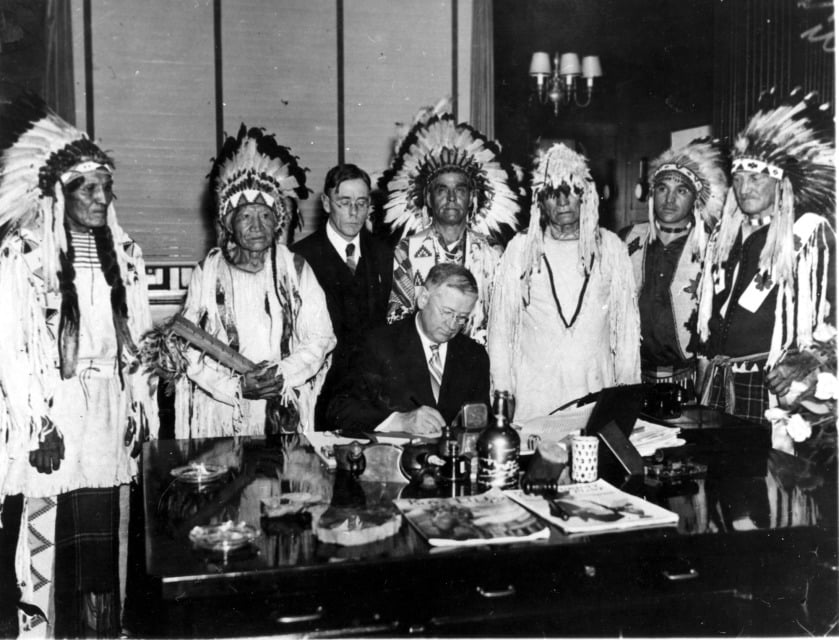The Indian Reorganization Act

( – promoted by navajo)
Guided by the Constitution, the United States viewed Indian tribes as sovereign nations and thus negotiated treaties with them. By the 1880s, however, American greed and lust for land outweighed any concerns for the Constitution and law. American policy changed and sovereign Indian nations were viewed as impediments to the “civilization” of Indians and a barrier to relieving Indians of their aboriginal homelands. Indians were now seen as immigrants who should assimilate just as other immigrants had assimilated. By the 1920s, it was evident to most people that American Indian policy had created massive poverty. With the election of Franklin Roosevelt and the implementation of the New Deal, American Indian policy changed radically.
In spite of strenuous objections by Christian missionary groups, Congress passed the Indian Reorganization Act (IRA, also known as the Wheeler-Howard Act) in 1934. The IRA has three objectives: (1) economic development of the tribes, (2) organization of tribal governments, and (3) Indian civil and cultural rights.
Those tribes who voted to reorganize under the IRA were able to adopt their own constitutions and to organize themselves into self-governing entities under federal guardianship. They were also able to incorporate for business purposes. There were, however, a couple of problems with this. First, the federal government viewed the concept of “tribe” and “reservation” as being synonymous. This ignored the fact that there were many reservations which contained more than one tribe and that the tribes on a single reservation often had totally different cultures and histories. Once again, the federal government policies seemed to view all Indians as the same and to ignore the reality of tribal differences. As a result, a number of confederated tribal councils were formed.
The second problem was that the tribes were not truly free to govern themselves. All actions of the tribal council were subject to review and approval by the Secretary of the Interior. In reality, the reservation superintendent, an employee of the Indian Office (later known as the Bureau of Indian Affairs), controlled all tribal council actions. As representative of the Department of the Interior, the superintendent had the power to veto council decisions. The superintendent also acted as custodian of tribal records.
The tribal governments formed under the IRA were not based on traditional Native governments, but on constitutions which were based on the U.S. Constitution. In most cases, the Indian Office supplied the tribes with a boiler-plate constitution which could be modified for their specific tribe(s).
A total of 181 tribes voted for the IRA and 77 tribes rejected it. Of the tribes who voted for the IRA, 93 tribes wrote constitutions which were based on the U.S. Constitution rather than on tribal custom.
There were many reasons why some tribes did not endorse the IRA. It was not uncommon for tribes to be suspicious of the federal government and its motives based on previous dealings with the federal government. There was also a fear that the IRA would increase government paternalism over their lives. Among some tribes, there was a greater interest in having the federal government recognize their treaty rights than in organizing new tribal governments which would be controlled by the BIA. The Yakama, in their testimony before the Senate, stated:
“We feel that the best interests of the Indians can be preserved by the continuance of treaty laws and carried out in conformity with the treaty of 1855 entered into by the fathers of some of the undersigned chiefs and Governor Stevens of the territory of Washington.”
The largest tribe to reject reorganization was the Navajo. Many of the Navajo were disturbed by a stock reduction program promoted by Commissioner of Indian Affairs John Collier which was intended to reduce overgrazing by limiting tribal herds. Many Navajos felt that a vote for the IRA was a vote for John Collier and thus a vote for stock reduction. Since Navajo sheep had great cultural value they were reluctant to support a program which seemed to attack their core values.
Under the IRA, tribes could create a federally chartered corporation which could borrow money, enter into contracts, and sue. The federal government envisioned the corporation as the primary vehicle for economic development on the reservations. Unlike other corporations, however, the tribal corporations were hampered by government micromanagement of their development proposals.
The Blackfeet in Montana were one of the first tribes to reorganize under the IRA. They embraced the IRA because it gave them access to credit and they felt it would reduce or eliminate federal control of the tribe’s financial and natural resources. By 1938 the Blackfeet had nearly $160,000 on deposit in the Treasury Department. None of this money was from the federal government, but was money that had been generated by tribal leases. A tribal delegation travelled to Washington, D.C. to obtain $125,000 of these funds for a program of industrial assistance. The Indian Office felt that the Blackfeet had a workable plan, but Congress granted the tribe the funds in reimbursable form. In other words, the tribe was allowed to borrow its own money, but it was not allowed to have it. It was clear that tribal corporations were not the same as other corporations.
Oklahoma was exempt from the IRA because of the opposition of Senator Elmer Thomas. Thomas argued that Oklahoma Indians no longer had reservations (these had been dissolved when statehood was granted). Furthermore, Senator Thomas claimed that Oklahoma Indians had no wish to reestablish reservations and they opposed any plan by Washington bureaucrats to impose reservations on them.
Even with its limitations, the IRA marked the beginning of a new era for Indian tribes. Once again, tribes were seen as sovereign with a right to self-government, even though that self-government was limited by a paternalistic federal system.


